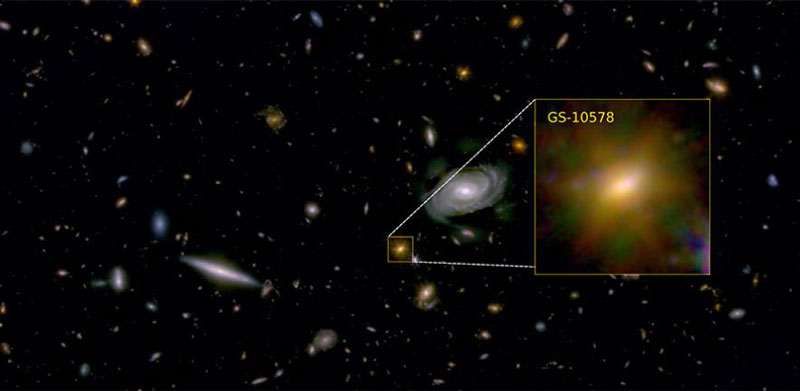The theory suggests that black holes in the centers of galaxies are capable of “blowing out the candle of their life” – depriving them of matter for the formation of new stars. Space Observatory named after. James Webb helped us see such a process with our own eyes – a supermassive black hole almost instantly, on the scale of the life of the Universe, starved the host galaxy to death.

Image source: University of Cambridge
Astronomers from the University of Cambridge became interested in the distant massive galaxy GS-10578, most of whose stars formed between 12.5 and 11.5 billion years ago. Thanks to Webb’s infrared sensitivity, such observation was possible for the first time in incredible detail. Galaxy GS-10578 has a mass of about 200 billion solar masses. For the youth of the Universe, this is roughly equivalent to the mass of the Milky Way, our home galaxy (the mass of the Milky Way is 1.2–1.9 trillion solar masses). The surprising discovery was that, on the scale of the Universe, star formation in GS-10578 stopped very quickly. The galaxy quickly grew to a gigantic size for that time and “died.” Why?
Webb’s infrared sensitivity helped detect cold gas escaping from the galaxy at a speed of more than 1000 km/s. This is the speed that allows matter to overcome the gravitational pull of the galaxy GS-10578, thereby depriving it of “food” for the birth of new stars. Clouds of cold gas do not show up in Webb’s observational spectrum, but he was able to determine their clusters and speed of escape from the attenuation of light from background stars in the galaxy. Previously, such measurements (of cold gas) could only be made using radio telescopes, so Webb was truly surprising. Scientists intend to refine the data obtained using an array of antenna arrays of the Atacama Large Millimeter/Submillimeter Array (ALMA) radio telescope. At a minimum, ALMA will be able to look inside the galaxy and try to detect at least some cold fuel for the process of birth of new stars.
«Based on earlier observations, we knew that this galaxy was in a dying state: not many stars were forming in it, given its size, and we expected that there was a connection between the black hole and the end of star formation, the authors of the work explain. “However, until Webb arrived, we could not study this galaxy in sufficient detail to confirm this connection, and we did not know whether this suppressed state was temporary or permanent.”
The physics of the process is simple. Matter falls into a black hole and causes energy and matter to be ejected away from it. A stream of particles constantly “blows” from the black hole, carrying molecular gases and dust away from the center of the galaxy and, as we see, even away from it.
«